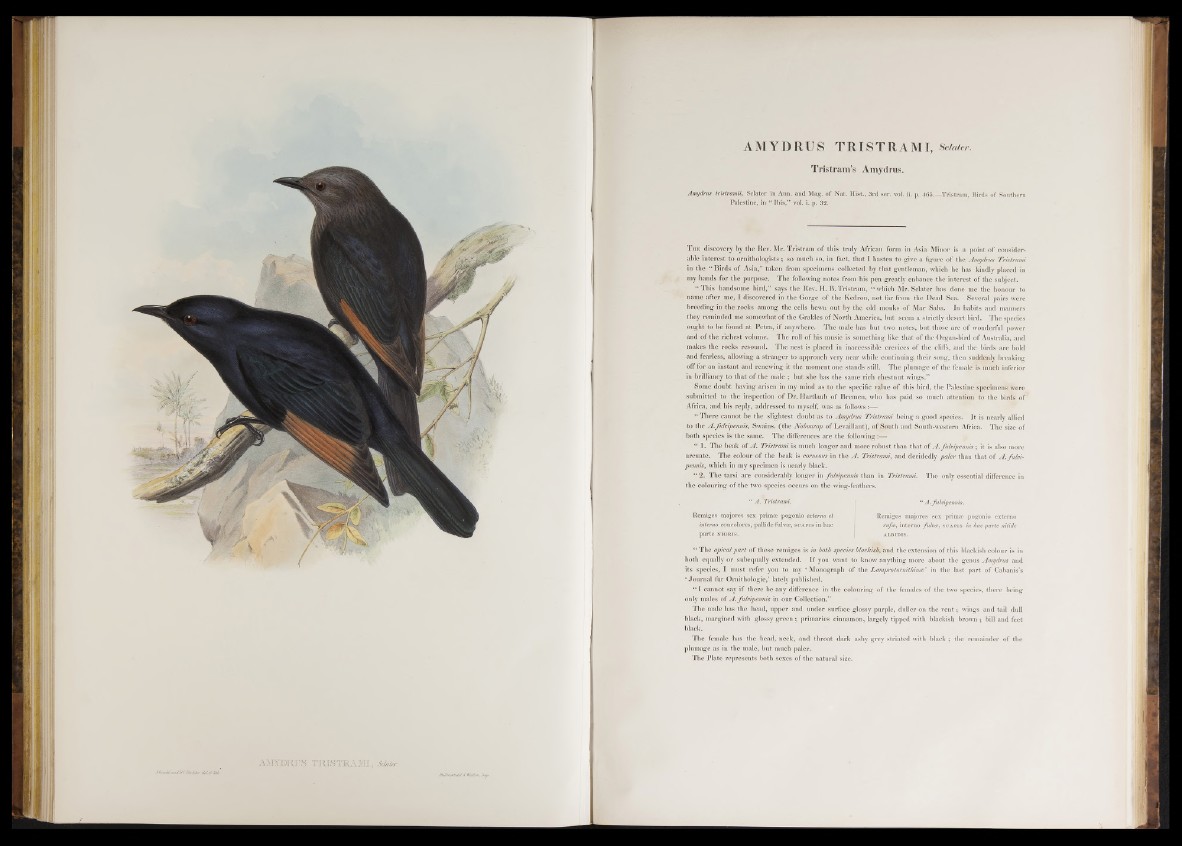
A im jR I T S T R I S T R A M I , Sc/jtler.
AMYDRUS TRISTRAMI , Sclater.
Tristram’s Amydrus.
Amydrus tristramii, Sclater in Ann. and Mag. o f Nat. Hist., 3 rd ser. voi. ii. p. 465,—Tristram, Birds of Southern
Palestine, in “ Ibis,” voi. i, p. 32.
T h e discovery by the Rev. Mr. Tristram o f this truly African form in Asia Minor is a point of considerable
interest to ornithologists; so much so, in fact, that I hasten to give a figure of the Amydrus Tristrami
in the “ Birds of Asia,” taken from specimens collected by that gentleman, which he has kindly placed in
my hands for the purpose. The following notes from his pen greatly enhance the interest of the subject.
“ This handsome bird,” says the Rev. H. B.Tristram, “ which Mr.Sclater has done me the honour to
name after me, I discovered in the Gorge o f the Kedron, not far from the Dead Sea. Several pairs were
breeding in the rocks among the cells hewu out by the old monks o f Mar Saba. In habits and manners
they reminded me somewhat of the Grakles of North America, but seem a strictly desert bird. The species
ought to be found a t Petra, if anywhere. The male has but two notes, but those are of wonderful power
and of the richest volume. The roll of his music is something like that of the Organ-bird of Australia, and
makes the rocks resound. The nest is placed in inaccessible crevices of the cliffs, and the birds are bold
and fearless, allowing a stranger to approach very near while continuing, their song, then suddenly breaking
off for an instant and renewing it the moment one stands still. The plumage of the female is much inferior
in brilliancy to that o f the male ; but she has the same rich chestnut wings.”
Some doubt having arisen in my mind as to the specific value of this bird, the Palestine specimens were
submitted to the inspection of Dr. Hartlaub of Bremen, who has paid so much attention to the birds of
Africa, and his reply, addressed to myself, was as follows:—
“ There cannot be the slightest doubt as to Amydrus Tristrami being a good species. It is nearly allied
to the A.fuhipennis, Swains, (the Naboitrop of Levaillant), of South and South-western Africa. The size of
both species is the same. The differences are the following
“ 1. The beak of A. Tristrami is much longer and more robust than that o f A. fuhipennis; it is also more
arcuate. The colour of the beak is corneous in the A. Tristrami, and decidedly paler than that o f A .fu h ipennis,
which in my specimen is nearly black.
“ 2. The tarsi are considerably longer in fuhnpennis than in Tristrami. The only essential difference in
the colouring o f the two species occurs on the wing-feathers.
“ A. Tristrami. I “ A.fulvipennis.
Remiges majores sex primse pogonio externo et Remiges majores sex priuue pogonio extemo
intemo concolores, pallide fulvee, s c a p i s in h ac rufce, interno fulvce, s c a p i s in hue parte nitide
p a rte n i g r i s . | a l b i d i s .
“ T he apical part of these remiges is in both species blackish, and the extension of this blackish colour is in
both equally or subequally extended. If you want to know anything more about the genus Amydrus and
its species, I must refer you to my 4 Monograph of the Lamprotornithinee’ in the last part of Cabanis’s
‘ Journal fiir Ornithologie,’ lately published.
“ 1 cannot say if there be any difference in the colouring of the females of the two species, there being
only males of A. fuhipennis in our Collection.”
The male has the head, upper and under surface glossy purple, duller on the v e n t; wings and tail dull
black, margined with glossy g ree n ; primaries cinnamon, largely tipped with blackish brown ; bill and feet
black.
The female has the head, neck, and throat dark ashy grey striated with black ; the remainder of the
plumage as in the male, but much paler.
The Plate represents both sexes of the natural size.